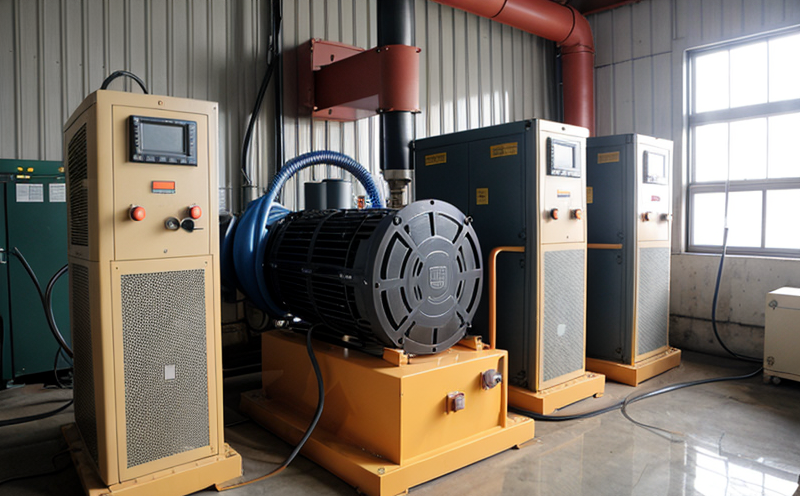IEC 60308 Vibration Testing of Turbine Equipment
The International Electrotechnical Commission (IEC) 60308 is a standard that specifies the methods for determining and measuring the vibration levels in rotating machinery, including turbines. This service focuses specifically on the vibration testing of turbine equipment to ensure compliance with IEC 60308 requirements.
Turbine equipment used in power generation systems operates under harsh environmental conditions. Vibration can be a critical factor affecting the performance and longevity of these components. By adhering to the stringent standards outlined in IEC 60308, we ensure that our testing provides reliable data on potential issues before they escalate into costly failures.
The testing process involves several key steps: equipment preparation, instrument calibration, data acquisition, analysis, and reporting. Our team uses state-of-the-art vibration analyzers and software to capture precise measurements across multiple frequencies. This allows us to identify any anomalies indicative of wear or misalignment early on.
For accurate results, it is essential that the specimens being tested are prepared according to specific guidelines provided within IEC 60308. Proper setup ensures consistent readings which can then be used for comparative purposes over time if necessary.
The vibration testing procedures outlined in this standard apply equally well across various types of turbines such as steam, gas, and hydroelectric units. Each type has unique characteristics that influence how they respond to vibrations; however, all share commonalities when it comes to assessing their health through vibrational signatures.
Once the test is complete, our experts analyze the collected data using advanced computational techniques. They interpret these findings against internationally recognized standards like IEC 60308, ensuring that any deviations from acceptable limits are clearly identified. The final report includes detailed insights into areas requiring attention along with recommendations for corrective actions if needed.
By offering this service, we help power generation facilities maintain optimal operating conditions for their turbine equipment while minimizing downtime and associated costs due to unexpected failures. This proactive approach not only enhances operational efficiency but also contributes significantly towards environmental sustainability goals by reducing energy consumption and emissions.
Why It Matters
The importance of IEC 60308 vibration testing cannot be overstated, especially for organizations involved in the power generation industry. Regular inspections allow for timely identification of potential problems before they lead to catastrophic failures that could disrupt service or cause significant financial losses.
- Reduces Downtime: Early detection enables preventive maintenance measures which significantly reduce unplanned shutdowns, thereby enhancing overall operational reliability.
- Prolongs Equipment Lifespan: Identifying issues early helps extend the useful life of critical components like turbines, leading to substantial savings over their lifecycle.
- Ensures Compliance: Adhering to international standards such as IEC 60308 demonstrates commitment to quality and safety, fostering trust among stakeholders including customers, suppliers, and regulatory bodies.
- Sustains Environmental Responsibility: Efficient operation of power generation equipment contributes positively towards reducing greenhouse gas emissions and promoting sustainable practices.
In summary, implementing IEC 60308 vibration testing is crucial for safeguarding the integrity of turbine equipment, ensuring safe and efficient operations while supporting broader sustainability objectives within the sector.
Scope and Methodology
The scope of our IEC 60308 vibration testing service encompasses a comprehensive approach aimed at evaluating the vibratory characteristics of turbine equipment. This includes both stationary parts (like bearings) as well as rotating elements such as shafts and impellers.
- Preparation: Specimens are carefully prepared following prescribed procedures detailed in IEC 60308 to ensure accurate measurement.
- Instrumentation: High-precision vibration analyzers equipped with accelerometers, strain gauges, and other sensors collect precise data points.
- Data Acquisition: Measurements are taken at multiple locations around the turbine to capture full three-dimensional motion patterns.
- Analysis: Collected data undergoes rigorous analysis using sophisticated software tools designed specifically for interpreting vibrational signatures.
The methodology employed adheres closely to international standards ensuring consistency and accuracy. Our team of experienced professionals ensures that every aspect from setup to final report generation meets the highest quality benchmarks set forth by IEC 60308.
This structured approach guarantees reliable, repeatable results capable of guiding informed decision-making processes related to equipment health management strategies.





